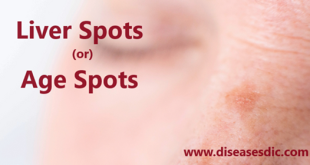Sweet syndrome – Overview
Sweet syndrome is a rare condition that involves a painful rash, typically along with a fever. The rash erupts mostly on the skin of the arms, neck, head, and trunk. The cause of Sweet’s syndrome isn’t fully known, but there are several typical scenarios in which it is known to occur.
Sweet syndrome
In some people, sweet syndrome seems to be triggered by an infection, or is possibly associated with inflammatory bowel disease and pregnancy; in others, it may be associated with cancer, most commonly acute myelogenous leukemia; still, others have a drug-induced form of Sweet’s syndrome.
Sweet’s syndrome may go away on its own, but it is commonly treated with corticosteroid pills, such as prednisone. Sweet’s syndrome is also known as acute febrile neutrophilic dermatosis or Gomm-Button disease.
Epidemiology of Sweet syndrome
The sweet syndrome has no racial predilection. It is more common in females than males by a ratio of 3:1. Most cases have occurred between the ages of 30 and 50 years, however, reported age groups to range from 2 to 75 years.
Pathophysiology of Sweet syndrome
- Sweet syndrome is an idiopathic disorder. Dysregulation of immune function or an immune-mediated hypersensitivity to an eliciting bacterial, viral, or tumor antigen may trigger the development or promotion of Sweet syndrome.
- Laboratory studies show the presence of various cytokines, circulating autoantibodies, immune complexes, human leukocyte antigen serotypes, dermal dendrocytes, and leukotactic mechanisms which may be playing a role in the pathogenesis of Sweet syndrome.
Types of Sweet syndrome
The condition is identified by three different types:
Classical
- Usually in women aged 30 to 50 years
- Often preceded by an upper respiratory tract infection
- May be associated with inflammatory bowel disease and pregnancy
- About 1/3 of patients have a recurrence of the Sweet’s syndrome
Malignancy-Associated
- Maybe in someone already known to have cancer
- Maybe in someone whose blood cancer or solid tumor was previously undiscovered
- Most commonly related to acute myelogenous leukemia, but other cancers possible, such as breast or colon
Drug-induced
- Most commonly occurs in patients who have been treated with granulocyte-colony stimulating factor given to boost white blood cells
- However, other medications may also be associated; drugs linked to Sweet’s syndrome include azathioprine, certain antibiotics, and some nonsteroidal anti-inflammatory drugs
Sweet syndrome – Risk factors
Sweet’s syndrome is uncommon, but certain factors increase your risk, including:
Sex: In general, women are more likely to have Sweet’s syndrome than are men.
Age: Though older adults and even infants can develop Sweet’s syndrome, the condition mainly affects people between the ages of 30 and 60.
Cancer: Sweet’s syndrome is sometimes associated with cancer, most often leukemia. Sometimes, Sweet’s syndrome may be associated with a solid tumor, such as breast or colon cancer.
Other health problems: Sweet’s syndrome may follow an upper respiratory infection, and many people report having flu-like symptoms before the rash appears. Sweet’s syndrome can also be associated with inflammatory bowel disease.
Pregnancy: Some women develop Sweet’s syndrome during pregnancy.
Drug sensitivity: Sweet’s syndrome may result from sensitivity to medication. Drugs linked to Sweet’s syndrome include azathioprine (Azasan, Imuran), granulocyte colony-stimulating factor, certain antibiotics, and some nonsteroidal anti-inflammatory drugs.
Causes of Sweet syndrome
The cause of Sweet syndrome is unknown. Doctors use three categories to classify Sweet syndrome:
Classical: The disorder occurs with other medical conditions like upper respiratory infections, pregnancy, or gastrointestinal infections.
Malignancy-associated: Sweet syndrome appears with certain types of cancer, like acute myeloid leukemia.
Drug-induced: Certain medications trigger Sweet syndrome. These include some antibiotics, like Bactrim, NSAIDS, and granulocyte colony-stimulating factor (G-CSF), which stimulates your body to make neutrophils, a type of immune system cell.
Symptoms of Sweet Syndrome
Signs and symptoms of Sweet’s syndrome:
- Fever is the most prominent and troublesome symptom. Fever may be present continuously throughout the period of illness.
- Edema is a common clinical finding with fever and skin lesions.
- Skin lesions are red, painful, tender and elevated in nature. Skin lesions may be single or multiple. The most common sites are the face, trunk, and extremities.
- Skin lesions may be papules, macules, pustules or plaques.
Erythematous plaques and nodules with central bullous changes on a child’s knee
- There may be edema causing vesicles on the skin.
- Skin lesions may be large and fluid filled in malignancy-associated Sweet’s syndrome.
- The larger skin lesions may tend to ulcerate.
- Smaller multiple skin lesions may join to form one huge skin lesion.
- The lesions resolve without any scar formation. Skin lesions have a tendency to recur.
- Constitutional symptoms like muscle aches, generalized weakness, and loss of appetite are also present.
- Signs and symptoms of Sweet’s syndrome may be preceded by an upper respiratory tract or a gastrointestinal tract infection.
Sweet’s syndrome in the pediatric population
Complications of Sweet syndrome
The possible complications of Sweet’s Syndrome include:
- Sweet’s Syndrome can lead to recurring episodes of the described inflammatory skin lesions. There is a risk that the skin lesions may become infected
- Some of the skin lesions may occur in other parts of the body, including the ears, eyes, heart, and lung, and may have organ-specific complications
- Anemia is seen to commonly occur in patients with Malignancy-Associated Sweet’s Syndrome and Drug-Induced Sweet’s Syndrome
Diagnosis and Test
Tests that are useful in Sweet’s syndrome include:
Skin biopsy: This is an important test. A sample of the abnormal skin may be taken by your dermatologist. The skin sample is then examined under a microscope in the laboratory. It takes time for the sample to be processed and analyzed by a pathologist (specialist doctor) so you will not get the result on the day.
Blood tests such as high levels of a type of white blood cells called neutrophils can help to make a diagnosis of Sweet’s syndrome.
Imaging: Your doctor may recommend other blood tests or imaging studies such as X-rays or CT scans to look for an underlying cause of Sweet’s syndrome is suspected.
If a medication is thought to be responsible, your doctor may recommend stopping it for a while to see if this improves your symptoms
Treatment and medications for Sweet Syndrome
To speed up the healing process of Sweet syndrome, certain medications are needed. However, this condition may go away on its own without treatment.
Sweet’s syndrome can be treated by corticosteroids, which come in a variety of forms, including:
- Oral corticosteroids such as prednisone work very well but may have side effects
- Creams or ointments. A convenient form of medication that is is applied in the affected areas of the skin
- A small amount of corticosteroid is injected directly to the affected area of the skin where the lesion is visible
Corticosteroids ate not intended for long-term administration. Your doctor may prescribe some alternative medications which may include:
- Dapsone
- Potassium iodide
- Colchicine
Prevention of Sweet syndrome
Protecting your skin from prolonged sun exposure is a good way to avoid recurrences of Sweet’s syndrome. According to the Mayo Clinic, good sun protection practices include the following:
- Use sunscreen with a sun protection factor (SPF) of at least 15, with both UVA and UVB protection.
- Wear protective clothing, including items such as wide-brimmed hats, long-sleeved shirts, and sunglasses.
- Avoid scheduling outdoor activities for midday and early afternoon, when the sun is the strongest.
- Try to spend time in shady areas when you’re outside.
 Diseases Treatments Dictionary This is complete solution to read all diseases treatments Which covers Prevention, Causes, Symptoms, Medical Terms, Drugs, Prescription, Natural Remedies with cures and Treatments. Most of the common diseases were listed in names, split with categories.
Diseases Treatments Dictionary This is complete solution to read all diseases treatments Which covers Prevention, Causes, Symptoms, Medical Terms, Drugs, Prescription, Natural Remedies with cures and Treatments. Most of the common diseases were listed in names, split with categories.








very nice article on sweet syndrome.All details mentioned.
Congrats !
is this a part of climate change is first time I’m hearing of this syndrome
It might occur due to climate change also. It depends on individuals.
thanks but my body scratch the moment I put water what will I do
I really need your help please
Try to make your body in a dry condition which makes to ease from scratch.
is the sweet syndrome contagious
It’s not contagious
Am having a sweet starch on scrotum sac, what should I do
Maintain a hygienic health